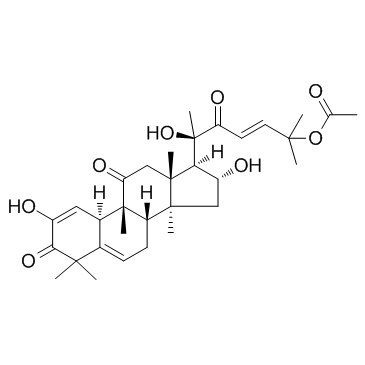The induction of G2/M cell-cycle arrest and apoptosis by cucurbitacin E is associated with increased phosphorylation of eIF2alpha in leukemia cells.
Yanchun Li, Rui Wang, Enlong Ma, Yihui Deng, Xiaolong Wang, Jinfang Xiao, Yongkui Jing
文献索引:Anticancer Drugs 21(4) , 389-400, (2010)
全文:HTML全文
摘要
The antiproliferative and apoptotic effects of cucurbitacin E, a natural product isolated from Cucurbitaceae, were determined in human leukemia HL-60 cells. Cucurbitacin E at low concentrations (3-50 nmol/l) inhibited the growth of HL-60 cells, which was associated with G2/M cell-cycle arrest, decrease in the levels of cyclin-dependent kinase1, and increase in the levels of p21. Cucurbitacin E at high concentrations (1-10 mol/l) induced apoptosis of HL-60 cells and activation of caspase-3, caspase-8, and caspase-9. Jurkat leukemia cells with or without caspase-8 expression were nearly equally sensitive to cucurbitacin E-induced apoptosis. Cucurbitacin E did not increase the levels of reactive oxygen species and antioxidants, N-acetylcysteine and catalase, did not block cucurbitacin E-induced apoptosis. Cucurbitacin E decreased the levels of the antiapoptotic proteins XIAP, survivin, and Mcl-1, but increased the level of the proapoptotic protein, Bax. The levels of phosphorylated eukaryotic translation initiation factor 2 subunit (eIF2) were induced in cells undergoing both apoptosis and cell-cycle arrest. As phosphorylated eIF2 is an inhibitor of protein translation initiation, our data suggest that cucurbitacin E induces cell growth arrest and apoptosis through the induction of eIF2 phosphorylation, which leads to the inhibition of cyclin-dependent kinase 1, Mcl-1, survivin, and/or XIAP protein synthesis and that cucurbitacin E induces apoptosis mainly through a mitochondrial-mediated pathway.
相关化合物
| 结构式 | 名称/CAS号 | 分子式 | 全部文献 |
|---|---|---|---|
 |
葫芦素 E
CAS:18444-66-1 |
C32H44O8 |
|
Interaction of cucurbitacins with human serum albumin: Therm...
2009-06-03 [J. Photochem. Photobiol. B, Biol. 95(3) , 189-95, (2009)] |
|
Quantitative determination of cucurbitacin E and cucurbitaci...
2008-12-01 [Pharmazie 63(12) , 851-3, (2008)] |
|
Effect of cucurbitacins on bilirubin-albumin binding in huma...
2007-01-16 [Life Sci. 80(6) , 579-85, (2007)] |
|
Immunomodulatory activity of cucurbitacin E isolated from Ec...
2005-07-01 [Fitoterapia 76(5) , 439-41, (2005)] |
|
Growth inhibitory effect of Cucurbitacin E on breast cancer ...
2013-01-01 [Int. J. Clin. Exp. Pathol. 6(9) , 1799-805, (2013)] |